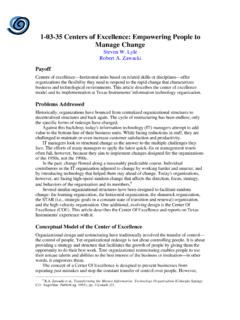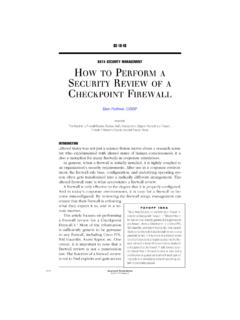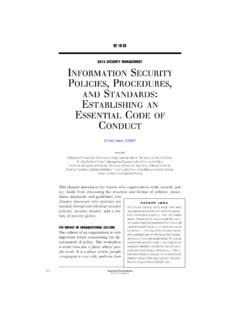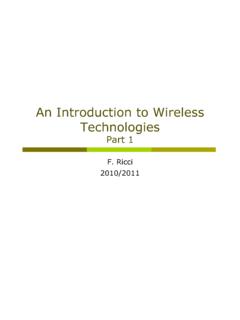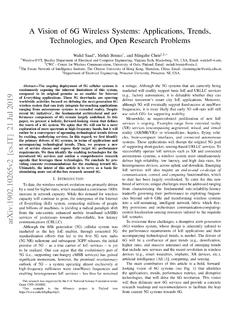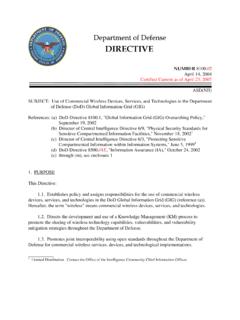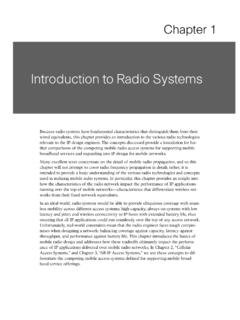Transcription of 5G Overview: Key Technologies - IT Today
1 Chapter 2. 5g overview : Key Technologies Meisam Khalil Arjmandi Contents Why 5G?..19. What is 5G?..24. Applications for 5G Key Technology for 5G Conclusion and Future Why 5G? Before discussing the structure and characteristics of fifth generation (5G), it seems that the necessity for designing such a network should be clearly explained. Therefore, it is informative to review previous network generations. 1G is the first generation of wireless telephone technology, which provides a speed of up to Kbps. The voice calls provided by this network are limited to one country and the network is based on using an analog signal. There are many pitfalls with 1G, such as poor voice quality, poor battery life, large phone size, limited capacity, and poor hand-off reliability. The second generation is 2G, which is based on the global system for mobile communication (GSM).
2 This network uses digital signals and its data speed is up to 64 Kbps. This network provides services such as text 19. 19 1/27/16 8:34 PM. 20 Opportunities in 5G Networks messages, picture messages, and multimedia messages (MMS). The quality and capacity of the network is also better compared with 1G. The high dependency of this network on strong digital signals and its inability to handle complex data such as video are its most important drawbacks. The technology between 2G and third generation (3G) was called second and a half generation ( ), which was a combination of 2G cellular technology with general packet radio service (GPRS). The characteristics of this network are providing phone calls, sending and receiv- ing e-mail messages, enabling web browsing, and providing a network speed of 64 144 Kbps.
3 With the introduction of 3G in 2000, the data transmission speed increased from 144 to 2M Kbps. The prominent features of 3G are that it provides faster communication, enables sending and receiving large e-mails, and provides high-speed web, videoconferencing, TV streaming, and mobile TV. However, the license services for 3G are expensive and building the infrastructure is challeng- ing. Requiring a high bandwidth, large cell phones, and expensive 3G phones are other drawbacks of 3G. The new generation, which is called fourth generation (4G), provides communication with higher data rates and high-quality video stream- ing in which Wi-Fi and WiMAX are combined together. This network is able to provide speeds of 100 Mbps to 1 Gbps. 5G is expected to be a significant advance on previous networks especially 4G.
4 The quality of services (QoS) and security are significantly promoted in 4G while the cost per bit is low. In comparison with previous network generations, there are some issues with 4G such as greater power consumption (battery use), it is difficult to implement, the hardware required is too complicated, and the high cost of the equipment needed to implement the next- generation network. 5G, which is the subject of this chapter, is going to be the next generation. In brief, it aims to provide a complete wireless communication with almost no limitations. Considering all the advances in different areas, 5G is going to be responsible for providing a unique network that is able to broadcast large amounts of data in gigabits per second (Gbps), enabling multimedia newspapers and TV programs with high-definition (HD) quality.
5 Improving the dialing speed and the clarity of audio and video, and supporting interactive multimedia are other advantages of the 5G network. Table compares different network generations. Figure shows how 5G will collect all possible networks to establish a single thorough network. There are some main expectations from the 5G network to present a better tele- communication network. First, the 5G network aims to provide a very high data rate for huge number of users. It should also be able to support several simultaneous connections for deploying massive numbers of sensors. Compared with 4G, the spectral efficiency of the 5G network should be greatly enhanced. This network should also be compatible with 4G Long-Term Evolution (LTE) and Wi-Fi to pro- vide high-rate coverage and smooth communication with low latency.
6 Figure shows the variation in the volume of data traffic per month for the Internet protocol (IP) network in petabits. From Figure , it is clear that with this huge growth in demand for data transmission, we need a new generation network with high ability. 20 1/27/16 8:34 PM. Table Characteristics of Different Network Generations 21. Network 1G 2 3G 4G 5G. Deployment 1970/1984 1980/1999 1990/2002 2000/2010 2014/2015. Bandwidth 2 Kbps 14 64 Kbps 2 Mbps 200 Mbps >1 Gbps Technology Analog cellular Digital cellular Broadband width/ Unified IP and 4G + wwww CDMA/IP seamless combo technology of LAN/WAN/. WLAN/PAN. Service Mobile Digital voice, Integrated Dynamic Dynamic information telephony short messaging high-quality information access, variable audio, video, and access, variable devices with AI.
7 Data devices capabilities Multiplexing FDMA TDMA/CDMA CDMA CDMA CDMA. Switching Circuit Circuit/circuit for Packet except for All packet All packet access network air interface and air interface Core network PSTN PSTN Packet network Internet Internet Hand off Horizontal Horizontal Horizontal Horizontal and vertical Note: FDMA, frequency-division multiple access; LAN, local area network; PAN, personal area network; PSTN, public switched telephone network; TDMA, time-division multiple access; WAN, wide area network; WLAN, wireless local area network. 5g overview : Key Technologies 21. 1/27/16 8:34 PM. 22 Opportunities in 5G Networks Cellular 1G 60 GHz Femtocell; ultra- dense deployments Multihop networks;. device-to-device Vehicle networks Smart grid WiMAX; massive communications Wi-Fi Figure Multiple integrated wireless/access solutions that enable a long-term networked society.
8 70,000. 60,000. 50,000. 40,000. 30,000. 20,000. 10,000. 0. 2013 2014 2015 2016 2017 2018. Video Web, e-mail, and data File sharing Online game Figure Demand for transmission over IP in different years. Values are in petabit per month. 22 1/27/16 8:34 PM. 5g overview : Key Technologies 23. To achieve these goals, the 5G network must have the following characteristics: (1) it should be highly flexible and intelligent; (2) it should have a significant spec- trum management scheme; (3) it is expected to improve efficiency while decreasing the cost; (4) it should be able to provide an Internet of Things (IoT), including bil- lions of devices from different sources; (5) it should introduce flexible bandwidth allocation based on the demands of users (what and how much people want to buy);. and (6) it should be able to integrate with previous and current cellular and Wi-Fi standards, which give a high rate of communication and decrease delays.
9 In gen- eral, for 5G Technologies , issues that are under discussion are network densification and millimeter wave (mmWAV) cellular systems, and developing multiple-input, multiple-output (MIMO). 5G networks are required to handle multiple Technologies including Wi-Fi and LTE, provide multiple frequency bands, and support greater numbers of users compared with previous networks. Considering the implementation of the LTE. system in 4G and its maturity, researchers usually attempt to answer the question of whether this is needed for the next generation. The annual Visual Network Index (VNI) has made it clear that relying only on incremental advances on 4G will not satisfy the ever-increasing demands for more network capacity by a huge number of users [1]. During the last decade, there has been a remarkable increase in the use of smartphones, tablets, video streaming, and online games, so that establishing a new network with better performance is of great value.
10 Besides the growing volume of data, the number of devices and the data rate that is related to channel capacity will increase dramatically. Since using applications for personal communication attracts individuals of different ages and many companies are working on designing new ones, 5G will be responsible for covering all related issues [2 4]. These facts show how much engineers are responsible for innovating new technology to meet the requirements. There are several projects such as METIS [5] and 5 GNOW [6]. in which academic researchers are involved in designing and establishing the new network. Also, industry is working on 5G standardization activities. The requirements for a 5G system can be described by different terms. Table shows the current state and what is expected from the 5G network.
